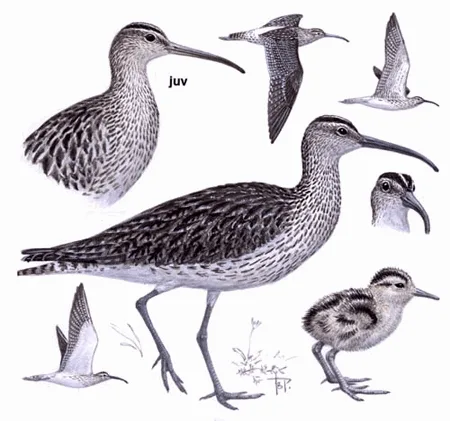
Whimbrel
[order] CHARADRIIFORMES | [family] Scolopacidae | [latin] Numenius phaeopus | [UK] Whimbrel | [FR] Courlis corlieu | [DE] Regen-Brachvogel | [ES] Zarapito Trinador | [NL] Regenwulp
Subspecies
| Genus | Species | subspecies | Breeding Range | Breeding Range 2 | Non Breeding Range |
| Numenius | phaeopus | NA, EU | n | widespread | |
| Numenius | phaeopus | alboaxillaris | w Kazakhstan to sw Siberia | coastal w Indian Ocean | |
| Numenius | phaeopus | hudsonicus | Hudson Bay area to ne Canada | Caribbean and South America, Australasia | |
| Numenius | phaeopus | islandicus | Iceland and British Isles | w Africa | |
| Numenius | phaeopus | phaeopus | Norway to nc Siberia | Africa, s and se Asia | |
| Numenius | phaeopus | rogachevae | c Siberia | ||
| Numenius | phaeopus | rufiventris | Alaska and nw Canada | w USA to South America | |
| Numenius | phaeopus | variegatus | ne Siberia | India to Australasia |
Physical charateristics
A large, relatively short-legged shorebird with a long down-curved bill, striped head, brown speckled upperparts and light underparts with streaking on the neck and upper breast. The underwings are light. Sexes similar in plumage, but female larger on average. Similar to adult, but back with light spots, crown stripe less distinct, breast more buff, and with finer streaking on neck and chest.
Listen to the sound of Whimbrel
[audio:http://www.aviflevoland.nl/sounddb/W/Whimbrel.mp3]
Copyright remark: Most sounds derived from xeno-canto
| wingspan min.: | 78 | cm | wingspan max.: | 88 | cm |
| size min.: | 37 | cm | size max.: | 45 | cm |
| incubation min.: | 27 | days | incubation max.: | 28 | days |
| fledging min.: | 35 | days | fledging max.: | 28 | days |
| broods: | 1 | eggs min.: | 3 | ||
| eggs max.: | 4 |
Range
North America, Eurasia : North
Habitat
Breeds in various tundra habitat, from wet lowlands to dry heath or wet taiga bogs that have scattered, stunted black spruce. In migration, frequents various coastal and inland habitats, including fields and beaches. Winters in tidal flats and shorelines, occasionally visiting inland habitats.
Reproduction
Breeds in various tundra habitat, from wet lowlands to dry heath. In migration, frequents various coastal and inland habitats, including fields and beaches. Breeding occurs May through July. Females usually lay four eggs in a depression they scraped out of the ground and lined with leaves. After 22-28 days of incubation, the eggs hatch. Young take about another month to fly.
Feeding habits
It fattens up during the fall migration at coastal and terrestrial habitats such as heaths and oyster banks. During the winter, it forages in tidal flats, mangroves and a variety of other coastal habitats. This curlew has a broad diet but its main food is marine invertebrates. Crabs are a favorite prey of wintering birds. In the fall, when staging for migration in the Canadian Maritimes and coastal Maine, Whimbrels eat berries and even flowers during breeding season. Berries are pulled off a branch with the tips of the bill. The bird then flips its head back and swallows. Insects are eaten in the same way.
Conservation
This species has an extremely large range, and hence does not approach the thresholds for Vulnerable under the range size criterion (Extent of Occurrence <20,000 km2 combined with a declining or fluctuating range size, habitat extent/quality, or population size and a small number of locations or severe fragmentation). Despite the fact that the population trend appears to be decreasing, the decline is not believed to be sufficiently rapid to approach the thresholds for Vulnerable under the population trend criterion (>30% decline over ten years or three generations). The population size is extremely large, and hence does not approach the thresholds for Vulnerable under the population size criterion (<10,000 mature individuals with a continuing decline estimated to be >10% in ten years or three generations, or with a specified population structure). For these reasons the species is evaluated as Least Concern.

Migration
Migratory. West Palearctic population winters mainly in Afrotropical region and on islands and coasts of western Indian Ocean. Very few winter in Europe (irregularly north to Denmark), and only sparingly from North Africa to Persian Gulf. Migrants not scarce in European coastal areas, especially around British Isles, but great majority probably pass overland on broad fronts, overflying large regions between relatively few staging areas. Especially important numbers halt in Hungary and interior of Low Countries (mainly Netherlands) in spring, but rather few in autumn when (so far as known) European passage (chiefly August-September) is without major roosting or feeding concentrations.
Many summer in African wintering areas; probably all 1-year-olds do so. Otherwise, spring departure from Afrotropics begins in March, including long Saharan crossings. Early birds reach Europe in late March, though main passage in second half April and first 10 days of May; breeding grounds reoccupied in May, or June in northern Russia.
Many summer in African wintering areas; probably all 1-year-olds do so. Otherwise, spring departure from Afrotropics begins in March, including long Saharan crossings. Early birds reach Europe in late March, though main passage in second half April and first 10 days of May; breeding grounds reoccupied in May, or June in northern Russia.
Distribution map

